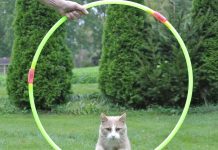Difficulty: Easy
Verbal Command: Sit.
Hand Signal: fist
Since different cats respond better to certain methods, we’ll offer two methods of training how to sit. The first method is designed only for cats that have already learned how to “stand up” on their hind legs, and relies heavily on proper timing. The second method is (sometimes) more forgiving on timing, but may be tough on a cat with little patience.
Method 1
Catch The Behavior
The name of this game is timing! While your cat may be too energetic to naturally sit when seeking a treat, many will naturally sit for a split second while going into or coming out of the “stand up” command. Ask for your cat to stand up, and observe how he gets in and out of the position. If he sits when coming out of the command, this method should work well for you. Ask him to stand up again, except bring your hand down into a fist when releasing him from the “up”. Click and treat as soon as his hind end touches the ground.
Recognize The Command
In short sessions, continue to repeat the exercise. Try hesitating before rewarding and see if he is able to sit for a second longer. If he is able to sit and wait for the treat, then he is able to recognize the command and you can add the firm verbal cue of “sit”.
Separate “Sit” From “Up”
Since you want your cat to be able to sit in any situation, start performing the hand signal and verbal cue without asking for him to stand up. Click and treat for proper effort, and have patience if he needs to think about the command at first. If it is needed, go back to the previous step and ask him to sit longer before progressing again. Hesitate longer before rewarding to extend his time sitting, and use a release word of “okay!” to tell him he may exit the position.
Applications
“Sit” is a good command to use for encouraging polite house-manners. Asking your cat to sit prior to giving him his meals, and that will help reduce unwanted begging behaviors. If he knows that he must sit to receive his meals, it may discourage him from displaying unwanted behaviors at meal time. If you want a cat to stop a behavior, then give them an alternative and preferable behavior to exhibit! In addition, the “sit” cue is perfect if you want to stage cute family photos for your Christmas cards or Instagram (see Maestro above, sporting a great “sit” in his PJs for a photo)!
Method 2
Lure Into Sit
For this method, move the treat slightly above the cat’s nose in a way that encourages him to move back on his haunches. Some cats will simply back up to try to eat the treat, so you may have to raise the treat to make the cat look up (and therefore put the hind-end down). Click and treat as soon as the hind-end touches the ground. Remember that you aren’t looking for perfection when starting out! It takes time for a cat to understand what you’re asking them to do.
Add Cues
Once kitty reliably lures into the sitting position, say “sit” and show him the hand signal prior to luring. With consistency, kitty should put the two ideas together and realize that the signals are a request for him to sit. Try hesitating before luring once you have introduced the cues for a day or two.
Consistency
Phase out luring and only use the cues. Kitty should learn to consistently sit every time you request it, and you can even try using only one cue (either verbal or visual). This is an easy task to work on daily, so don’t let it slip!













